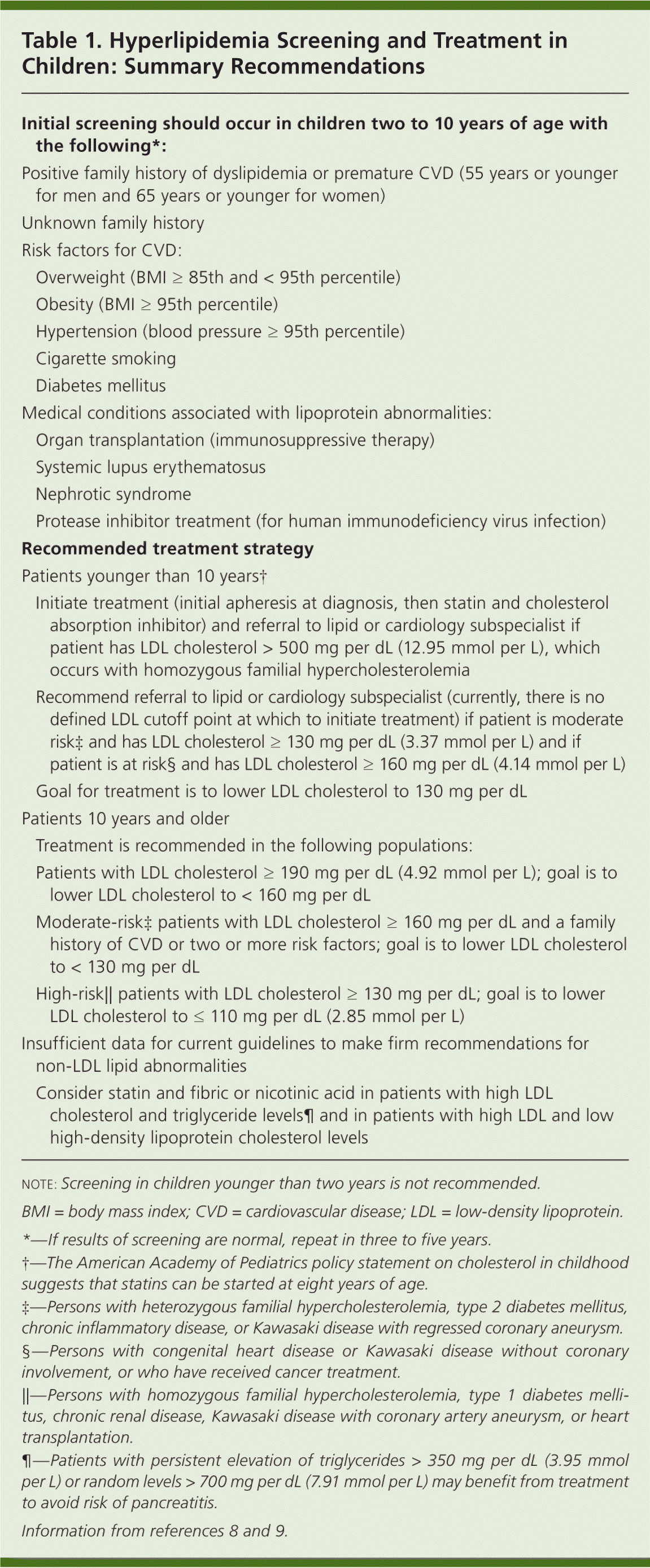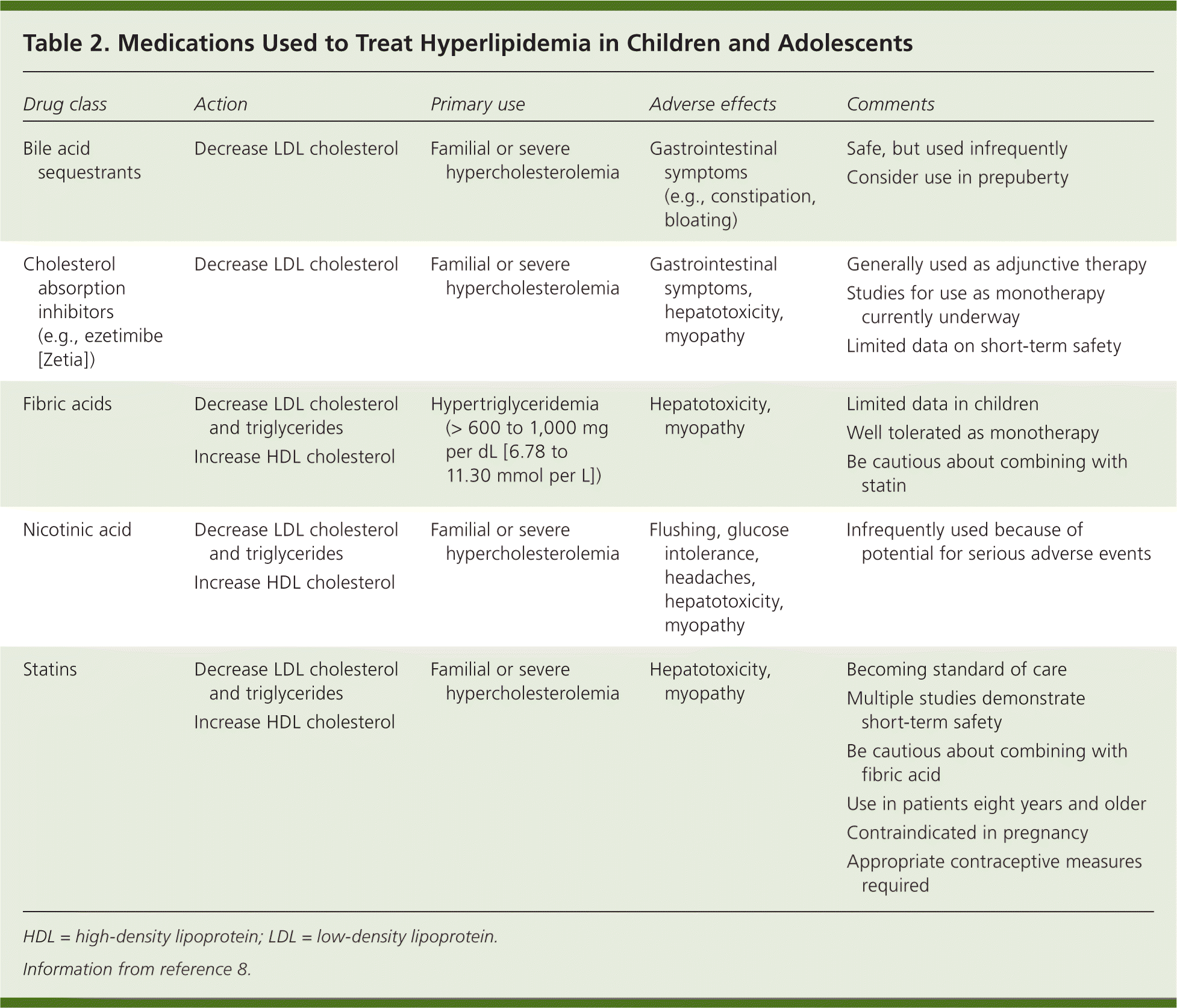
Am Fam Physician. 2010;82(5):460-467
This is one in a series of pro/con editorials discussing controversial issues in family medicine.
Cardiovascular disease is the leading cause of death in the United States. There is substantial evidence that the atherosclerotic process begins in childhood, with the presence of fatty streaks in the aorta by 10 years of age and in the coronary arteries by 20 years of age.1 Atherosclerotic lesions, which occur in up to 38 percent of persons with multiple risk factors, are more common in young persons with elevations in serum total cholesterol and low-density lipoprotein (LDL) levels; body mass index; and systolic and diastolic blood pressures.2–4
Furthermore, studies in adolescents have shown that mean carotid intimamedia thickness measured by ultrasonography is strongly associated with cardiovascular risk factors and predictive of coronary artery disease and cerebrovascular accidents. Most of these studies evaluated persons with familial hypercholesterolemia in whom carotid intimamedia thickness was increased and the rate of change was much greater than in the control population.5
The percentage of children with hyperlipidemia appears to be increasing. Data from the National Health and Nutrition Examination Survey between 1988 and 1994 found that 10 percent of adolescents had total cholesterol levels greater than 200 mg per dL (5.18 mmol per L).6 In the more recent Child and Adolescent Trial for Cardiovascular Health, 13.3 percent of children nine to 10 years of age had total cholesterol levels greater than 200 mg per dL.7 Despite no long-term studies evaluating the effectiveness of screening for dyslipidemia in childhood and its effect in delaying or reducing the incidence of cardiovascular-related events, the American Academy of Pediatrics released an updated clinical policy statement in 2008 on lipid screening and cardiovascular health in childhood. The recommendations are summarized in Table 1.8,9

| Initial screening should occur in children two to 10 years of age with the following*: | |
| Positive family history of dyslipidemia or premature CVD (55 years or younger for men and 65 years or younger for women) | |
| Unknown family history | |
| Risk factors for CVD: | |
| Overweight (BMI ≥ 85th and < 95th percentile) | |
| Obesity (BMI ≥ 95th percentile) | |
| Hypertension (blood pressure ≥ 95th percentile) | |
| Cigarette smoking | |
| Diabetes mellitus | |
| Medical conditions associated with lipoprotein abnormalities: | |
| Organ transplantation (immunosuppressive therapy) | |
| Systemic lupus erythematosus | |
| Nephrotic syndrome | |
| Protease inhibitor treatment (for human immunodeficiency virus infection) | |
| Recommended treatment strategy | |
| Patients younger than 10 years† | |
| Initiate treatment (initial apheresis at diagnosis, then statin and cholesterol absorption inhibitor) and referral to lipid or cardiology subspecialist if patient has LDL cholesterol > 500 mg per dL (12.95 mmol per L), which occurs with homozygous familial hypercholesterolemia | |
| Recommend referral to lipid or cardiology subspecialist (currently, there is no defined LDL cutoff point at which to initiate treatment) if patient is moderate risk‡ and has LDL cholesterol ≥ 130 mg per dL (3.37 mmol per L) and if patient is at risk§ and has LDL cholesterol ≥ 160 mg per dL (4.14 mmol per L) | |
| Goal for treatment is to lower LDL cholesterol to 130 mg per dL | |
| Patients 10 years and older | |
| Treatment is recommended in the following populations: | |
| Patients with LDL cholesterol ≥ 190 mg per dL (4.92 mmol per L); goal is to lower LDL cholesterol to < 160 mg per dL | |
| Moderate-risk‡ patients with LDL cholesterol ≥ 160 mg per dL and a family history of CVD or two or more risk factors; goal is to lower LDL cholesterol to < 130 mg per dL | |
| High-risk∥ patients with LDL cholesterol ≥ 130 mg per dL; goal is to lower LDL cholesterol to ≤ 110 mg per dL (2.85 mmol per L) | |
| Insufficient data for current guidelines to make firm recommendations for non-LDL lipid abnormalities | |
| Consider statin and fibric or nicotinic acid in patients with high LDL cholesterol and triglyceride levels¶ and in patients with high LDL and low high-density lipoprotein cholesterol levels | |
The American Heart Association expert panel has also identified children at higher risk of premature atherosclerosis. These children require closer surveillance and more aggressive treatment. Children at highest risk are predicted to have symptomatic coronary artery disease before 30 years of age and include patients with homozygous familial hypercholesterolemia and type 1 diabetes mellitus.9 Additional cardiovascular risk stratification and risk reduction strategies are outlined at http://circ.ahajournals.org/cgi/content/full/114/24/2710.
Pharmacologic treatment of hyperlipidemia in children has evolved over the past decade (Table 2).8 Statins have led to significant reductions in cardiovascular and all-cause mortality for adults. As a result, there has been increasing experience with and clinical trials of statin use in children with familial hypercholesterolemia. Statins have supplanted the less effective and less tolerated bile acid sequestrants as mainstay therapy. One randomized controlled trial (n = 214; two-year study) and one recent meta-analysis (six studies; n = 798; 12 to 104 weeks of treatment) evaluating the safety and effectiveness of statins in children with familial hypercholesterolemia found no statistically significant increases in adverse events compared with placebo (relative risk = 0.99; 95% confidence interval [CI], 0.79 to 1.25). Analysis of the pooled data showed a significant 30 percent reduction in LDL cholesterol (95% CI, –36 to –24 percent). No differences were observed for muscle or liver toxicity or Tanner staging.10,11

| Drug class | Action | Primary use | Adverse effects | Comments |
|---|---|---|---|---|
| Bile acid sequestrants | Decrease LDL cholesterol | Familial or severe hypercholesterolemia | Gastrointestinal symptoms(e.g., constipation, bloating) |
|
| Cholesterol absorption inhibitors(e.g., ezetimibe [Zetia]) | Decrease LDL cholesterol | Familial or severe hypercholesterolemia | Gastrointestinal symptoms, hepatotoxicity, myopathy |
|
| Fibric acids | Decrease LDL cholesterol | Hypertriglyceridemia (> 600 to 1,000 mg per dL [6.78 to 11.30 mmol per L]) | Hepatotoxicity, myopathy |
|
| Increase HDL cholesterol | ||||
| Nicotinic acid | Decrease LDL cholesterol and triglycerides | Familial or severe hypercholesterolemia | Flushing, glucose intolerance, headaches, hepatotoxicity, myopathy |
|
| Increase HDL cholesterol | ||||
| Statins | Decrease LDL cholesterol and triglycerides | Familial or severe hypercholesterolemia | Hepatotoxicity, myopathy |
|
| Increase HDL cholesterol |
Despite short-term safety of statins, long-term monitoring for muscle and liver toxicity in children and adolescents is essential; however, based on current evidence, concern for adverse events is not a reason to withhold statin therapy in this population. Indeed, there is evidence that early statin therapy may be beneficial, because regression of carotid intimamedia thickness has been demonstrated in children taking statins compared with progression in placebo-controlled groups.12,13 Currently, lovastatin (Mevacor), simvastatin (Zocor), pravastatin (Pravachol), and atorvastatin (Lipitor) are approved by the U.S. Food and Drug Administration for use in children.
The prevalence of lipid abnormalities continues to grow and is associated primarily with the obesity epidemic and metabolic syndrome. Despite the absence of data in children demonstrating morbidity and mortality reduction by aggressive treatment of lipid disorders, the overwhelming data in adults (e.g., decreasing LDL cholesterol, improved morbidity and mortality) and evidence of atherosclerotic lesions developing in childhood support the argument for early treatment.
